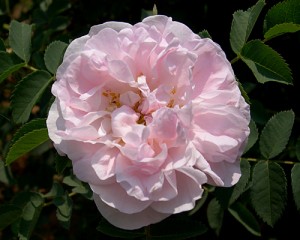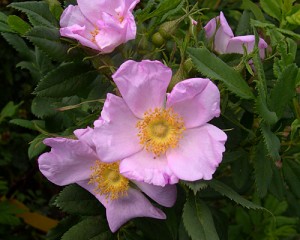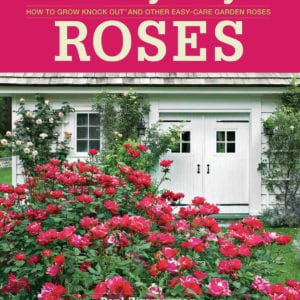(A Note. This article is in progress with detailed information still being added to all the classes.)
The article is in three parts
Sp. Species. Species roses are the wild roses of the world and by most estimates there are about a one hundred and forty that occur in the Northern Hemisphere. To date it is believed there are no wild roses has evolved naturally south of the equator. Peter Beales in his book ‘A Passion for Roses’ breaks the species roses down to the four main regions that are found to be growing naturally. They are: Europe, Asian Minor, Asia and North America.
Europe. The most common species in Europe is R. canina or the dog rose. It is frequently used as the backbone of English Hedgerows and is also used as understock for colder parts of Europe. Additionally Mr. Beales lists R. rubiginosa, R. eglanteria and R. pimpinellifolia, formerly known as r. spinosissima, as roses frequently found wild in Europe. It is worth noting that R. eglanteria is particularly known for its apple scented foliage and R. pinpimellifolia for its tolerance of extreme cold and poor soil conditions. The latter grow as small shrubs making them invaluable for the garden. A few like Stanwell Perpetual and Aicha will repeat throughout the season.
Asian Minor. Perhaps the most known species roses from this region is R. foetda. It later gave rise to R. foetida ‘Persiana’, which was used in the breeding of Soleil d’Or and introduced the yellow/orange color to the breeding of roses. Today’s hybrid yellow varieties can almost all be traced back to R. foetida ‘Persiana’.
Asia. The most important species to come from this area is R. chinensis, also known as R. indica. Used as the parent for several China Hybrids brought to Europe in the last 18th and early 19th centuries, the repeat flowering characteristic of roses can be traced back to this rose. Four of those hybrids, ‘Old Blush’, ‘Slater’s Crimson’, ‘Hume’s Blush’ and ‘Park’s Yellow’, became known as the four stud Chinas. Mr. Beales also points out that of all the garden-worthy wild roses those from Asia have the showiest hips – a very important part of their appeal and use in a garden.
North America. Colorful autumnal foliage is a trait that most species from this region have
in common. The most brilliant display comes from R. virginiana and is followed by lots of small, orange-red hips. R. nitida, R. nutkana and R. californica are others well worth growing as is R. palustris for its open habit, large pink blooms and remontant qualities.
Species Roses in the garden. From an orderly garden where a spot of joyous chaos can lend a touch of spontaneity to a wilder area of the garden where the can freely mix with other plants of the same ilk; Species Roses, with their wide range of growth characteristics make them invaluable garden plants. They are terrific when grown as hedges where their variance of characteristics is on full display. Their hips are a great source of food for birds in winter in addition to a colorful display – particularly against a fresh snowfall. The varieties with showy fall foliage should be planted in any garden where this is a desirable feature.
They are virtually care free and need little more than any shrub growing on its own in the garden. After all they have stood the test of time of their own and outside of cleaning out of dead wood and the taking out of an old cane they are best left to their own devices.
The main reason gardeners give for not growing species roses is that they are spring flowering, meaning they flower only in spring for on average a month or so. This argument should be overlooked as they are attractive shrubs even when not in flower and serve as a backdrop to summer and autumnal flowering perennials and shrubs. In addition their fall foliage and display of hips extend their “showy” season well beyond the spring.
A. Alba. Also known as ‘The White Roses’ they are derived from a cross of R. canina with probably R. damascena. With the former they share smooth stems, healthy gray-green foliage and shrubby habit. Another characteristic is for the most part they are more tolerant of shade than other roses.
Spring flowering in habit, their graceful growth habit and color of foliage provide a terrific backdrop for other plants in the garden. The blooms are fragrant despite their nickname also come in exquisite shades of pink. Albas should also be used in hedges and natural woodland plantings where dappled light is present. They tend to be very winter hardy.
Albas need very little care other than removal of dead wood and the occasionally taking out of an old cane to make room for new ones. If desired they can be kept to shrub shape by using the methods developed for shrub roses. They do not take to being hard-pruned.
Ayr. Ayrshire. R. arvensis at one point produced a little group of double ramblers mostly white. Some accounts have the name coming about because the first double form of R. arvensis was supposedly found in a village in Ayrshire, Scotland. A few are still in commerce today such as ‘Bennett’s Seedling’ and ‘Venusta Pendula’, ‘Ayrshire Splendens’ is fragrant and considered to be perhaps the most outstanding example of this class.
In the garden the Ayrshire roses are very hardy and grow in a prostrate fashion, making them terrific ground covers. This would suggest they could be useful for weed and erosion control on hillside. The other unique characteristic of these roses is they thrive in a thin woodland setting where they thrive being grown into trees.
Like most ramblers the Ayrshire need little care. Removal of dead wood, taking out of the odd old cane are about all they need.
B & Cl B. Bourbon and Climbing Bourbon. So named because most experts believe the first rose of this class occurred on the Ile de Bourbon (now known as Ile de Réunion). The first was ‘Rose Edouard’ the result of a spontaneous cross between a China rose, probably ‘Old Blush’, and the Damask rose, most likely an early form of ‘Quatre Saisons’. When Rose Edouard arrived in France in about 1818 it was quickly realized that it’s rounded, fully double, fragrant blooms that appeared from spring to fall not only made it a good rose for commerce but valuable breeding stock. At that time repeat flowering roses were limited to the Chinas and a few Portlands. In Rose Edouard repeat flowering was now found in a bloom with the look and fragrance of Old European Roses.
In the garden the Bourbons offer a wide variety of characteristics. Some are short and busy and, others will produce large arching canes and some make excellent climbers. Almost all repeat flower but there are a few that do not and some class them as Hybrid Bourbons so as to keep them separate.
From the China roses the Bourbons inherited a silky quality to their petals making they outstanding roses for the mixed border. Their range of color from white to pink to red and even some striped, easily allows them to mix with other plants and roses. In a border of old roses their repeat flowering quality extends the season. Those with longer canes take well to pegging, being grown as pillar roses and for covering a short fence.
In some climates they can be prone to blackspot but good plant husbandry and mixing in perennials, annuals and shrubs will minimize that. Left alone some will build up disease resistance as they mature. Pruning should be done with a light hand. Removal of dead wood, an occasional old cane and on the larger varieties bringing the laterals back to within a foot of the main cane is about all that is needed. If desired they can be kept to shrub shape by using the methods developed for shrub roses. They do not take to being hard-pruned.
Bslt. Boursalt. Hybrids of the central European species R. pendulina the first was a near species known as R. x l’heritierana. Most Boursaults are climbers of which ‘Mme de Sancy de Parbère’ is the perhaps the best known example.
In the garden they useful for growing into trees, covering walls and some can even be grown as very large free standing shrubs. For the most part they are thornless and feature blooms in large clusters.
As with many roses like this the less care the better. Prune out dead wood, occasionally remove an old cane and outside of that it’s best to leave them alone.
C. Centifolia. Not much is known about their true origin other than they have a very mixed heritage. In the sixteenth and seventeenth centuries they were widely hybridized by the Dutch, making them among the first group of roses to be developed this way. The Dutch most likely cultivated them as cut flowers and evidence of their work can be seen in many of the paintings of Dutch and Flemish old masters.
Their large flowers and many petals gave them nickname ‘Cabbage Roses’ and ‘hundred-petaled’ roses. The former nickname is often erroneously given to any multi-petaled rose with old rose characteristics.
In the garden their growth habit is from small and tidy to tall and sprawling. While they are spring flowering, their diversity of habit makes it easy to mix them with other shrubs in the garden. Stems can range from smooth to very thorny, a trait most likely due to the diversity of their background. What they do all have in common is excellent fragrance and large blooms in mostly shades of pink.
Centifolias need little care other than removal of dead wood and the occasionally taking out of an old cane to make room for new ones. If desired they can be kept to shrub shape by using the methods developed for shrub roses. They do not take to being hard-pruned.
D. Damask. From mixed parentage it is likely than many have origins in the Gallicas. Damask roses are highly prized for their attar, which is used by perfumeries for rose scents. For this reason they are excellent choices for making pot-pourri. Needless to say they are among the most fragrant group of roses we have.
Spring flowering; the shrub is attractive and the downy-gray ribbed foliage adds a nice note of texture to the garden. The growth habit is relaxed but not overly large either. They are excellent when used in borders, mingled with other perennials and shrubs. Damasks are winter hardy.
Damasks need little care other than removal of dead wood and the occasionally taking out of an old cane to make room for new ones. If desired they can be kept to shrub shape by using the methods developed for shrub roses. They do not take to being hard-pruned.
HBc. Hybrid Bracteata. Offspring from “the Macartney Rose” or Rosa barcteata. They tend to be climbers, very vigorous and unlike most other ramblers offer repeat bloom in the autumn. The other great characteristic is the wonderful glossy foliage and extremely sharp thorns. They make great security fences.
HCan. Hybrid Canina. These are hybrid versions of Rosa Canina, which is the species rose hedgerows in England are made of. As a group they are tough, cold hardy roses that bloom in the spring. The hybrids are showier and more manageable than the species version. Great roses for “wild” hedges and gardens.
HCh & Cl CH. Hybrid China and Climbing Hybrid China. A wonderful group of heavily repeating shrub roses. Their small stature makes them perfect for the front of the border or in pots. Sadly not winter hardy, but if you grow them in pots you can bring them indoors for the winter.
HEg. Hybrid Eglanteria. Also known as Sweet Briar roses, they are known for their distinctive apple scented foliage, and make wonderful garden shrubs when allowed to grow naturally. Some will even offer some repeat bloom later in the season. Winter hardy -another great use is to grow them tightly together as a hedgerow, a great natural security fence.
HFt. Hybrid Foetida. A group of very yellow roses with touches of sulfur. Mostly once blooming and very wild looking, they are a great addition to a more natural planting – perhaps even mixing them with wild grasses.
HGal. Hybrid Gallica. I’ve always loved these once blooming roses because they seem to be the only class that gives us a true almost purple color. Very fragrant these roses actually need some winter chill to bloom, much like lilacs.
HGia. HYBRID GIGANTEA. Off shots of the Gigantea rose from southwest China and upper Burma. They get HUGE. 40 feet or more up a tree is not uncommon. They are not winter hardy but in a warm climate, up a tree they are sight to behold.
HMult. Hybrid Multiflora. These are some of the true ramblers of the roses world and we plan to expand this collection in the years to come. Ramblers are not grown much in this country and it’s a shame because allowed to rumble up into a tree or a hedge they can usher in spring with a bang. Once blooming and winter hardy.
HP & Cl HP. Hybrid Perpetual and Climbing Hybrid Perpetual. This is a group of roses you either love or hate. Everyone agrees the flowers are among the most exquisite in the rose world. But the plant can sometimes be gangly in appearance. This can be remedied by cutting them back hard in the winter, or by planting behind other plants towards the back of the border where the blooms can be seen above them. As landscape shrubs the reliability of their repeat blooming, their fragrance and winter hardiness make them indispensable in the garden.
Hsem. Hybrid Sempervirens. Lovely graceful group of old ramblers, of which “Felicite Perpetue” might be the most well known. Good for up into trees as they cascade a shower of blooms every spring. Nearly evergreen, but slightly too tender for cold climates.
HSet. Hybrid Setigera. A great group of ramblers that will flower later in the season than most. They are very hardy and in most cases very fragrant.
HSpn. Hybrid Spinosissima. Once blooming smallish shrubs that are winter hardy and disease resistant.
HSte. Hybrid Stellata. Related to the native rose of the Texas and Arizona desert, this is a rose that actually prefers a lot of sun and very well drained soil. The are dwarf growing, with gray-green stems that form a wonderful small thicket.
MiscOGR. Miscellaneous Old Garden Rose. The catchall category. Each roses should be considered individually.
M. & Cl M. Moss and Climbing Moss. Known as Moss roses because of the “Moss” like hairs covering the buds. These are beautiful roses and are well worth growing. Winter hardy, most don’t repeat but some like Salet will recur during the year.
N. Noisette. The best group of climbing roses we have. Fragrant, graceful in growth habit, alas they are not winter hardy. They do great in our foothills area where nights get into the 20s but I don’t know how much further north they can go. In future years we will begin to see which ones can handle what climates and pass this on to you. One of my favorite class of roses.
P. Portland. (Damask Perpetual) This is an overlooked group of lovely landscape roses. Not tall in habit, repeat blooming, great textured foliage, hardy, fragrant they should be in every perennial border.
T & Cl T. Tea and Climbing Tea. Not hybrid tea but “Tea”. Why these aren’t more widely grown in gardens is a total mystery to me. They bloom heavily and are fragrant. The shrub when left to it’s own devices will grow into a well shaped four to five feet. Their only drawback is they are tender but grow them in pots (they love it) and bring them indoors.
F & Cl F. Floribunda and Climbing Floribunda. This is class of roses often over shadowed by the showier hybrid teas and it is too bad. As a rule they bloom heavily and make great landscape shrubs. Some are winter hardy.
Gr & Cl Gr. Grandiflora and Climbing Grandiflora. The blooms are very much like Hybrid Teas but the growth habit is taller and more upright. These are very useful landscape shrubs for against a house or at the back of the border.
HKor. Hybrid Kordesii. Repeat blooming and very, very winter hardy these are good landscape shrubs for a casual border in that they don’t like orderliness. Some can be used a short climbers.
Hmoy. Hybrid Moyesii. The species form of this created a sensation when it was introduced into cultivation in 1908 for its blood red colored flowers. The growth habit is of a very large upright shrub, once blooming a great display of hips in the autumn. Good for the back of the border or where you need to shade perennials from the direct sun.
HMsk. Hybrid Musk. A unique group of roses that are very useful in the garden because of their ability to thrive in dappled sunlight. As a plant they fill out to a graceful round shape that can anchor any border. In warm climates some can even be grown as short climbers.
HRg. Hybrid Rugosa. These are the roses that are found wild on the beaches of Maine. They are great landscape shrubs for their flowers and also for their pale green ribbed foliage. Very disease resistant, very hardy they don’t like spraying so be careful. I find in hot climates they like being planted where they are out of the mid-day sun.
HWich. Hybrid Wichurana. A group of rambling roses that gets its characteristics from R. Wichurana. They are tall growers with canes that are quite pliable making them very useful ramblers for those spots where the canes need to be trained like over arbors and such. Generally once blooming.
HT & Cl HT. Hybrid Tea and Climbing Hybrid Tea. These are not the hybrid teas we think of today but rather some of the early hybrid teas. They are good landscape shrubs in they repeat bloom and stay mid-sized in stature. They are also good for pots.
LCL. Large Flowered Climber. Exactly what they say they are some are repeat blooming and winter hardiness can vary. They are a beautiful group of roses that perhaps are hampered by being associated with today’s repeat climbing roses. At their best are more of a true rambling type rose.
Min & Cl Min. Miniature and Climbing Miniature. The climbers in this class are just like their little shrub cousins but they climb to about 6’. Very effective in a small garden or on a patio.
MiniFl. Mini-Flora. This is a new class of roses. Too large to be miniatures and to small to be Floribundas – hence the name Mini-Flora. They grow to around 2-3 feet in height and bear their blooms in sprays throughout the season. Great for mass planting, low hedges, front of the border or in pots.
Pol & Cl Pol. Polyantha and Climbing Polyantha. Also known sometimes as patio roses these are have blooms too big to be miniatures and too small to be Floribundas. Very popular in Europe they deserve to be more widely grown here. Great for that splash of color in a pot or at the front of the border.
S. Shrub. Another catchall class of roses they are wonderful roses for the landscape because as advertised they are shrubs. Sadly it’s become the class that everything gets dumped into that defies a neat description. One we have is a group of roses that grow all different ways and sizes. When shopping from this class (and we suggest you do) pay close attention to descriptions of growth habit to make sure you are getting what you need.



